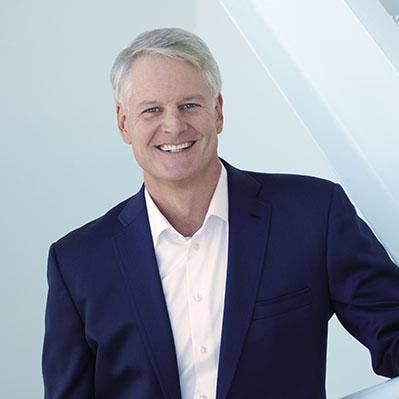10 Questions: ServiceNow CEO John Donahoe Talks Partners, Competition, And What Lies Ahead
ServiceNow CEO John Donahoe sat down with CRN at the company’s Knowledge 19 event in Las Vegas where he talked about the revamped channel program, how partners can help the company achieve $10 billion in revenue, and where the white-hot automation platform is placing its bets in 2019.

10 Questions With John Donahoe
ServiceNow CEO John Donahoe hosted Knowledge 19 this week in Las Vegas where the company has announced an overhaul of the partner program, new partnerships with Deloitte and Google Cloud, as well as lifting the lid on their product roadmap and showing off new capabilities around building apps for their mobile platform.
In a one-on-one with CRN, Donahoe – who has been CEO for just over two years -- said he is “ruthlessly focused” on customer success with the ServiceNow platforms, and sees the partner channel as critical to the company’s goal of reaching $10 billion in annual revenue.
“Take any of the channel partners, they have broader relationships across industries and a lot of industry expertise,” he said. “Within a given company, they tend to have broader relationships than we do. Its not just IT. They have deeper relationships and they bring an incremental skill set, that we don’t have.”
The former eBay CEO also chimed in on the runaway success partners are having with ServiceNow as well as his view on competitors in the platform automation space.

10. How much do you want to grow the channel at ServiceNow? Is there a percentage, or a number that you’d like to see it increase?
I don’t have a specific number. Here’s how I think about it. I spend all my time with customers. I’m ruthlessly focused on customers achieving successful outcomes. Not just buying our software and using our software. Are they getting value from it. That’s thought one.
The reason I think our partner ecosystem is so important is that most of our customers can’t get value from our software without a really responsible consulting partner, SI, that helps them redesign processes, drive change management, and do all the things it takes to get full value from software, in the world of digital transformation. At the highest level, our focus, and what David Parsons announced yesterday is just increased recognition that partners are really, really important.
For our shared customers to get results, within the partners a variety of them have MSP offerings, and there’s a variety of other companies that have MSP offerings. There is what I would characterize as healthy MSP and unhealthy MSP, and so there was an outsourcing wave that happened at one point where companies outsourced all their technology to MSPs, and a lot of that was probably good. I do talk to customers who say, ‘I’m really frustrated that I’m not getting value from ServiceNow because my MSP is on an old version and I have no control or authority over it.’ That’s not healthy.
So the MSPs we’re talking with, the healthy ones, is how do we build a healthy, forward looking call it MSP 2.0 or 3.0, where its customer needs aligns with what MSPs need, and aligned with what we need, and aligned to results, and taking advantage of a SaaS platform so they’re on the latest version, they’re getting the full value from the latest version, and then the MSP may add value around it, which we see can help add value. Its not just a go-to-market thing, it’s adding value to the industry verticals, or knowledge of a geography, or the size of a company that we might otherwise cover.
That’s why this is an important area. The problem is that we measure it in different ways, so if its just MSP reseller, or SI influenced.

9. What is the plan to help those MSPs who may not be up to speed?
I think it starts with having a platform that’s really easy to use and really easy to build upon. One of the hardest issues is then developing IP on it, and who owns what IP. So the partnership we just announced with Deloitte.
So part of what we’re talking about with Deloitte is who owns what IP if Deloitte goes out and sells that everywhere? And how do we make sure we stay coordinated, consistent and cogent on that. So we’re working hard, led by (ServiceNow Senior Vice President, Global Alliances & Channel Ecosystem) David Parsons, to find modern models of how to do that in a win-win, highly transparent way. We want people building on top of our platform. What we don’t necessarily want is someone that’s saying I’m sticking you into some blind, outsourcing relationship, the customer has no direct access to ServiceNow. We don’t want that. We’d rather go direct.
So the market is sorting its way out in that way.
8. Regarding the changes to the partner program: Do you consider this a revamp, a bigger investment in the channel for ServiceNow?
I’d say it’s a little of both. Certainly, even the time I’ve been here, the channel is a more important priority. Frankly, I’ve come from a consulting background, so I’m familiar with it. I’m comfortable with it. I see how one plus one could equal three.
We have quarterly, top-to-top meetings where we say what are our shared customers? What are we hearing from them? What are the shared opportunities? How do we coordinate with each other? What are they shared IP, or product investments we could do together? What the shared thought leadership? I have similar top quarter to quarter meeting with Deloitte, KPMG, I had one with Mike Lawrie at DXC two weeks ago. Being coordinated and working together and investing together, and saying you know what, lets really lean in. We lean in with Unisys in the US federal government. We’re going to lean in with Deloitte on this financial product we’re announcing. This close the book product. We lean in with Accenture in other areas. So we work with all of them, but we’re trying to do it in a coordinated and transparent way. So there’s no doubt, there’s more investment in it. Then we hired David Parsons who just has a wonderful track record having done this at VMware. And he’s driving a lot of what we’re doing. It’s trying to be smart. Its not just ‘Go sell some stuff for us.’

7. Two earnings calls ago, ServiceNow CFO Mike Scarpelli answered an analyst’s question about the channel, ‘We’re going to be trying a few new things, but no major changes at all to our sales organization. Why? Because it’s been working. We don’t want to mess that up.’ But it does seem like you are making some major changes so has anything changed between then and now?
Here’s where I reconcile those two statements. What financial analysts are looking for are, is ‘Should we increase our models because all of a sudden you have a go-to-market motion that is truly incremental from your direct sales team.’ And we’re saying ‘No.’ Don’t raise your models. Don’t all of a sudden assume that our sales rate is going to go up dramatically because someone else is selling all our stuff for us. That’s what Mike was saying, that direct sales is our primary motion. Now, in terms of expanding customer relationships, customer health, and some go-to-market, yes. We’re doing more with the channel. And we’re doing it more strategically and we’re doing it systematically. Mike heard a question where someone is saying ‘Can I get two points more of growth?’ And he’s saying ‘No. Nothing major on that front.’
But what David Parsons is saying is true. We’re doing more. And they’re all acknowledging it.
6. You’ve talked a lot about ServiceNow reaching for that $10 billion dollar mark in terms of annual revenue. Is that achievable without the channel?
No. No way. Because, take any of the channel partners. They have broader relationships across industries and a lot of industry expertise. Within a given company, they tend to have broader relationships than we do. It’s not just IT. They have deeper relationships and they bring an incremental skill set, that we don’t have. I’ve run a consulting firm, and I’ve run a software firm. They’re different businesses. We’re not going to do both. I don’t want to run a consulting firm. We’ll let Accenture do that. We’ll let Deloitte do that. They’re great at it. So it’s declaring we want to work together. It’s math. Revenue growing 40 percent, 38 percent. PS revenue growing 12 percent, maybe, less than that last year. That’s the opportunity for the channel.
Now, how do we work together to capitalize on that opportunity around implementation, around process management, and then also around go to market? Take what we’re doing with Deloitte. Deloitte has great relationships. They have a great CFO practice. They have a great SAP, Financial ERP practice. They have a great Oracle ERP practice. So, we’re going to work closely with them. They’ll help us bring to market our financial, close the books product, versus trying to hire 100 finance-oriented sales people.

5. We talked to some of your MSP partners, who were effusive in their praise, one of whom said, ‘We’re betting our business on ServiceNow.’ When you hear people say that, what is your reaction?
I love that. The leading modern platforms of today, technology platforms, part of what what makes them a platform is they open up the opportunity for others to build on top and earn a living. I love that. No one company has a monopoly on innovation, and certainly, that’s part of what makes us a platform.
Whether you’re a partner or an ISV, whether you’re a developer, building things on top and seeing opportunities that we’ll never get to, but building on top of it and saying, ‘Here’s our niche, where we can take ServiceNow’s platform and capability, build on top and take it and take it to a certain market.” We love that. We love the fact that people are building practices and building products and building capacities on top of the ServiceNow platform.
4. Where is ServiceNow placing its bets in 2019?
Investment priority number one is product. We’re a technology company. Product innovation is top of the heap. When I say product innovation, I also put platform innovation in there, so product and platform. You’ll see some of the things we’ve invested in for the past year announced (here), some of the mobile capabilities, some of the new products around DevOps and financial close the books.
We will continue to invest through our NowX capability, and the next generation of products. We’re continuing to broaden and deepen our mobile capabilities. We’re continuing to make our platform even easier to use. So product and platform is the number one innovation area.
Number two innovation area is around customer success, which is an extension of our go-to-market, which is also where a lot of what we just talked about fits in. I view partners as a key part of customer success, and go to market.
Number three is talent. We’re still growing our team.
Number four is our company brand. We were the best kept secret in the world. Now we’re trying to raise, not just with IT decision makers who know who we are, but with people in the C-suite, with our own employees, with recruits and others, building our employer brand. Those are our four major investment areas and we’ll continue to invest behind those.

3. You do have some competitors. Cherwell wants to take share from you. I think they’re pitting themselves as the scrappy underdog and looking for ways to nip at your heels. Are they on your radar?
We focus on customers. Not on competitors. As long as we’re continuing to meet customer needs, better than competitors, our business will grow. I look at the growth rates, and I think the growth rates speak for themselves. So, now, do competitors make us better? Yes. If its easier to use, then we need to be easier to use. So you see a huge focus on being easier to use. User experience. Easier to use and user experience are two different things. Easier to use, easier to implement, easier to manage supply, simpler, easier to upgrade. User experience. Do we have a modern user experience? Some start-ups in our space are building that, so we need to make sure the mobile capabilities you see, I would argue are best in class. Making sure that pricing is aligned.
Competition always makes you better, but I always look at it through the eyes of the customer. Are we serving the customer needs better than the competition? Certainly, in our core markets, we seem to be.
2. (CNBC host) Jim Cramer has asked you the same question twice and I don’t think you’ve given him an answer so I wanted to ask you: Is ServiceNow an ‘inflation buster?’
(Laughs) I’ve tried to answer it honestly. I never want to credit for a label that’s bigger than we are. What I do think is, inflation buster means this: Can software drive significant productivity improvements that fuels healthy economic growth, that sustains the business expansion period we’re in? That’s what I hear when he asks his question. When he asked it last time, I think the Fed Reserve chair had raised rates or lowered rates, and ‘Are we going to have a slow down?’
I think what our platform can do, in addition to driving significant improvements in user experience, is drive significant productivity savings that are healthy for our customers. And our customers can either reinvest those in innovation or use them to expand their earnings, and that creates economic growth.

1. What about this idea that automation products are going to result in fewer jobs in general and in technology in particular?
I am thoughtful around the extreme of that. There’s debate around, is automation going to kill all the jobs, or is automation going to take the 30 percent of our lives at work that are devoted to repetitive, administrative, redundant tasks that drive us crazy, and automate that part for our work lives, so instead of spending 70-percent of our time doing value added stuff, we spend 100-percent of our time doing value added stuff, and doing our creative best? That is what is in our purpose.
When we say, ‘We make the world of work, work better for people’ it’s a belief in that we can improve the quality of life at work.
Now will that result in fewer jobs? In the short term, you could say yes, because you’ve automated 30 percent of our lives at work. But will that create more economic growth and a higher quality of life? Yes.
We make automation software, but we can do it in a way that improves people’s quality of lives at work and we can do it in a way that’s socially responsible.